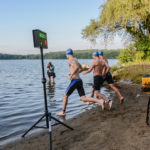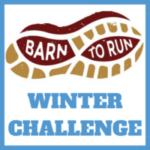Choosing Your First Triathlon
 So you’ve been hearing a lot about this triathlon thing lately and want to get in and see what the hype is all about. Maybe it was a New Year’s resolution, maybe your friend has been talking about it non-stop, maybe you are looking for a new way to challenge yourself. Whatever the reason may be… WELCOME! We are glad you’re here.
So you’ve been hearing a lot about this triathlon thing lately and want to get in and see what the hype is all about. Maybe it was a New Year’s resolution, maybe your friend has been talking about it non-stop, maybe you are looking for a new way to challenge yourself. Whatever the reason may be… WELCOME! We are glad you’re here.
There are many ways to set yourself up for a successful triathlon experience. And if you haven’t figured it out already, it is quite easy to get overwhelmed with information on training, equipment, nutrition, etc. All that stuff certainly plays a big role and you can go down any of those rabbit holes indefinitely. One easy thing that is often drastically overlooked and that is completely in your control is race selection. Although there is some consistency across triathlon race distances (a full distance tri is about 2x the distance of a half distance tri; a half distance tri is about 2x the distance of an olympic tri; and an olympic distance tri is about 2x the distance of a sprint tri; HINT: pick a sprint for your first tri!), races of a similar distance are definitely NOT created equal! Weighing the pros and cons of a few races is probably the easiest and cheapest way to set yourself up for a guaranteed fun time!
So, here are a few things to think about to make sure you pick the right race for YOU…
BEFORE YOU EVEN START
- Ask friends and other triathletes for opinions… triathletes LOVE giving their opinion (as you probably already have figured out) but truthfully it provides a good way for an athlete to get a general feel for a race or the organization producing it
- Timing is everything. If your race is early in the season, are you going to have enough time to train in good weather? If not, are you prepared to train indoors if you have to? If you answered in the negative, you may want to consider a later season race that allows you proper time to train outdoors.
- Most races start relatively early in the day. Meaning you have to get there earlier to set up your transition area. Meaning you have to wake up even earlier. How much travel are you comfortable with to get to the race location? Picking a race close to where you live offers the added advantage of getting on the course to train beforehand!
- Do you have friends or family coming to watch you? Is the race spectator-friendly? If you’re going to have friends, family and your fan club come to cheer you find out if they’ll have an easy time of seeing you… and if the venue or race has something to offer spectators outside of the race (e.g. a park for kids to play in, food, coffee, etc.).
STAYING AFLOAT: WHAT TO CONSIDER WITH THE SWIM
- The distance: Does the thought of the swim scare your goggles off? The distance of the swim is generally fixed at the full (2.4 miles), half (1.2 miles), and olympic distance (0.9 miles) but can vary for sprint tris between 0.25 and 0.50 miles. If you are a newer swimmer, look for a race with a shorter swim to take some of the pressure off!
 The start format: Just as there are various swim distances, there are various ways the swim may start at a race. The “mass” start is one where everyone in the race starts at once. 300 people in the race? Well, that means 300 athletes start the swim at once. This is rare and usually the most intimidating type of swim start. A “wave” start divides the athlete field into groups (usually divided by gender and age group) and starts a new group or wave every 3, 4 or 5 minutes. So, if your wave has 50 athletes, all 50 athletes start the swim at once. Lastly, there is the “rolling” or “time trial” start which starts 2-3 athletes every 10-15 seconds. The latter two of the three are a lot less daunting. Note: Many races will also have a “Newbie wave” or offer athletes anxious about the swim a different color cap to signify a beginner or “nervous” swimmer.
The start format: Just as there are various swim distances, there are various ways the swim may start at a race. The “mass” start is one where everyone in the race starts at once. 300 people in the race? Well, that means 300 athletes start the swim at once. This is rare and usually the most intimidating type of swim start. A “wave” start divides the athlete field into groups (usually divided by gender and age group) and starts a new group or wave every 3, 4 or 5 minutes. So, if your wave has 50 athletes, all 50 athletes start the swim at once. Lastly, there is the “rolling” or “time trial” start which starts 2-3 athletes every 10-15 seconds. The latter two of the three are a lot less daunting. Note: Many races will also have a “Newbie wave” or offer athletes anxious about the swim a different color cap to signify a beginner or “nervous” swimmer.- Swim conditions: Is the swim in a big lake or open ocean? Or is it in a small pond or bay? Find out if the water is going to be choppy or calm. What’s the normal water temp on race day? This can affect your decision on whether or not to get a wetsuit. Click here for a good article on deciding whether or not to get a wetsuit.
THE BIKE & RUN COURSE
- Open or closed? Most bike and run course are open to automobile traffic, but not all. A closed roads means there will be no car traffic to worry about All races will have safety officers and police details to help control traffic when you are riding or running, but roads closed to traffic offer peace of mind and an added safety factor.
 The distance: Along the same lines of the swim mentioned earlier, full (112 mile bike-26.2 mile run), half (56 mile bike-13.1 mile run) and olympic (28 mile bike-6.2 mile run) distance triathlons generally have set distances for the bike and run. Sprints can vary within a few miles for the bike and run. Do you want a longer bike? Or a shorter run? Review the website and know before you go and decide what suits you best!
The distance: Along the same lines of the swim mentioned earlier, full (112 mile bike-26.2 mile run), half (56 mile bike-13.1 mile run) and olympic (28 mile bike-6.2 mile run) distance triathlons generally have set distances for the bike and run. Sprints can vary within a few miles for the bike and run. Do you want a longer bike? Or a shorter run? Review the website and know before you go and decide what suits you best!- Hills: It is always a big topic of discussion from race to race and really it is just a matter of preference. Some people love a lot of elevation gain and some prefer a “pancake flat” type of a course. No matter where you stand, you should take a look at the elevation each course has to offer.
The bottom line: Being prepared is key! Nothing is ever “perfect”. Remember that you may not find a race that checks every single box, but that’s part of the challenge now it isn’t it? The most important part is to make a commitment, sign up and no matter what happens keep smiling. At the end of the day/race you will be happy that you just went for it… the time is now!
About the Author: Billy Hafferty is an enthusiastic endurance junkie and coaches running, cycling and triathlon. Currently training for the Ironman World Championship in Kona, Billy aims to inspire others to get outside and enjoy testing their limits while having fun. He’s rarely caught without a smile, joke, or uplifting advice. Feel free to contact him about anything triathlon related at [email protected]. Read more of his work here.
Beginner triathletes and Sun Multisport Events: All sprint distance triathlons produced by Sun Multisport Events feature a time trial swim start format, a “Friends, Families & Beginners” wave and the option for a “Nervous Swimmer” swim cap. We also offer a FREE training plan customized to each of our races courtesy of VMPS, Official Coach of the 2017 SME Triathlon Series. Beginners can look forward to an award-winnng race experience with great organization, cool swag (including a finisher medal to commemorate your achievement) and generous volunteer support. Our most beginner friendly race is the Whaling City Triathlon which offers a 0.25 mile swim, a flat 12 mile bike course closed to traffic and a 3.1 mile run all on walking paths and sidewalks. Set at historic Fort Taber Park, it’s also our most spectator-friendly race. Click here to learn more.

